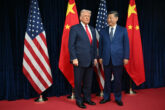September 26, 2018
The Second Coming of Kim Jong Un
The leaders of the United States and North Korea waited seventy years to have a first face-to-face encounter. That happened on June 12, when Chairman Kim Jong-un met President Donald Trump in Singapore. Now the pair is preparing for an encore encounter, which will mark the second summit in about four months.
The first coming of Kim brought the United States full circle from last year’s “maximum pressure” and “fire and fury;” the second coming of Chairman Kim is apt to go further, solidifying an end-of-war declaration as a quid pro quo for the beginning of verifiable denuclearization steps. Peace and denuclearization are the two tracks of North Korean diplomacy that must run in tandem, each depending on the other to maintain momentum, and both tracks exposing the U.S.-South Korean alliance—and North Korea—to new risks and vulnerabilities.
While appreciating Kim’s savvy diplomacy this past year, South Korean president Moon Jae-in is the essential choreographer of this diplomatic dance.
On Monday afternoon at the United Nations in New York, Moon briefed Trump on what specific steps Kim said he is willing to take toward dismantling nuclear and missile programs. He went beyond the public disclosure of possibly permanently closing the Yongbyon nuclear facility, something often negotiated in the past and which most analysts believe is no longer the only or main facility for producing weapons-grade nuclear fuel.
Moon also apprised Trump on what “corresponding measures” Kim expects in return for expediting denuclearization. Although the world knew that skeletal outline of a plan after Moon’s visit to Pyongyang last week, the South Korean president held onto the detailed information until he could brief Trump himself in the hope of persuading the U.S. president to return to the summit with Kim and embrace the politically controversial move of an end-of-war declaration as the minimum price for commencing denuclearization.
Read the full article at The National Interest
More from CNAS
-
North Korea Reveals Troop Dispatch to Russia amid U.S.-South Korea Policy Talks
North Korea has confirmed for the first time that its troops are operating in Russia, and it is preparing to rewrite its party charter with the possibility of officially namin...
By Dr. Go Myong-Hyun
-
Chinese Maker of Bitcoin-Mining Machines Is a Security Threat, Says Expert
Bloomberg News reports that a Chinese manufacturer, Bitmain Technologies Ltd, that sells most of the world’s Bitcoin-mining machines — including 16,000 of them to a venture ba...
By David Feith
-
Indo-Pacific Security / Energy, Economics & Security
North Korea’s Provocations, Power Plays, and Shifting AlliancesTensions on the Korean Peninsula have reached a new and dangerous threshold. President Lee Jae Myung is warning of a real risk of accidental military clashes, as the situation...
By Dr. Go Myong-Hyun
-
Indo-Pacific Security / Energy, Economics & Security
How to Win the Economic War with ChinaTrump's approach to China has run aground, giving Beijing unprecedented advantage in the economic conflict....
By Edward Fishman & Julian Gewirtz



